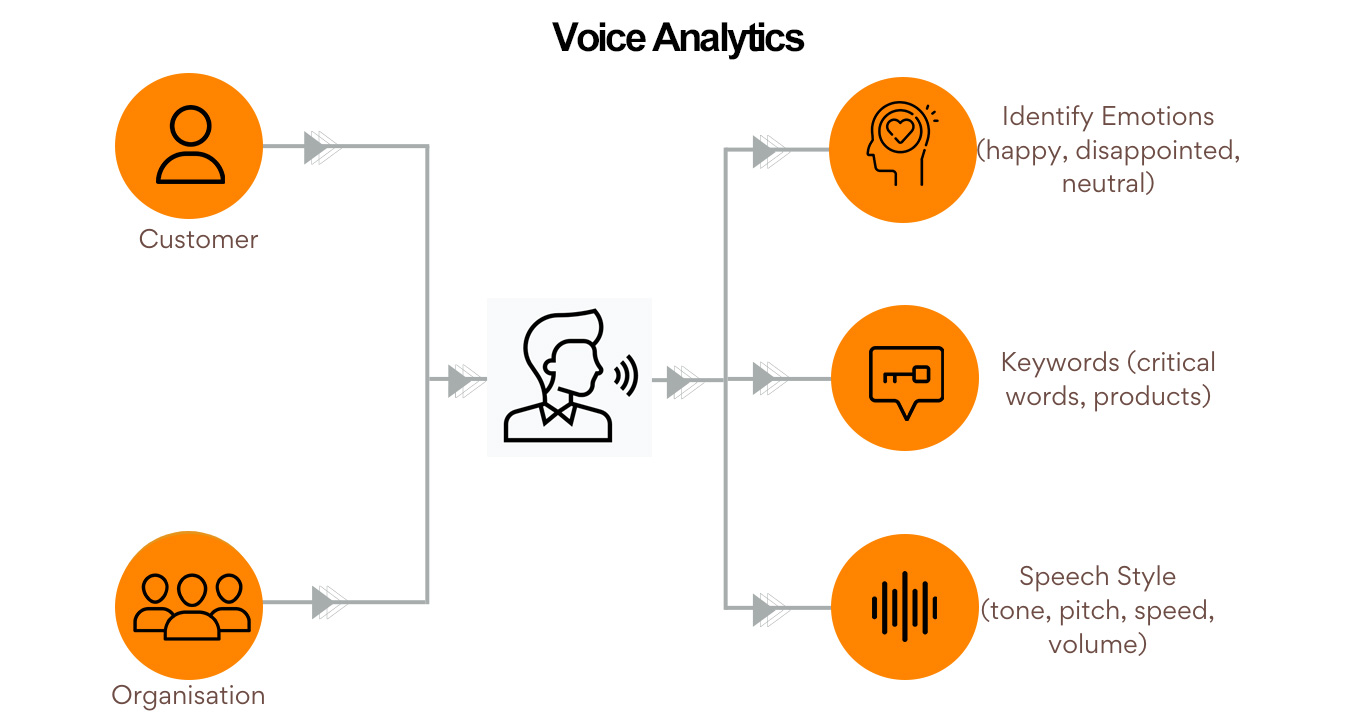Voice analytics is an innovative technology that enables businesses to extract valuable insights from spoken language. Businesses today must use technology to their advantage due to the intense competition in the market. Voice analytics is one of the technologies that has shown to be quite beneficial to numerous businesses across various industries.
It is a useful method for assessing client sentiment, recognizing emotions, and examining the customer experience. everything through analysis of client and customer conversations.

An Overview of Voice Analytics
Voice analytics is the act of delving further into talks that have been recorded on video, during digital conferences, or over the phone.
Natural language processing (NLP) and machine learning combine to provide voice analytics. By analyzing auditory patterns, it can translate speech, determine purpose, and recognize emotion. Insights obtained from the platform might be simple or complicated and multi-layered depending on organizational needs.
It was initially used to create correct transcripts, but over time it grew into a more sophisticated platform that uses artificial intelligence and machine learning to perform what it is capable of doing now.
Voice Analytics Advantage Functions
Voice analytics is used in many business functions such as:
Build Sentiment Analysis
Understand intonation, intonation and rhythm, and incorporate word choice. The program can predict customer emotions and identify emotions. Users can then filter and categorize incoming calls based on their sentiment (positive, neutral, and negative) and take necessary corrective action.
Extract Keywords
Extract keywords used in the conversation and filter out keywords - product names, sensations, and others that are important to understand the context of the conversation. This will also help organizations strategize for calls that mention certain keywords, providing better guidance to sales and customer service teams.
Expand Topic Analysis
This feature allows the identification of keywords and timestamps. A useful feature that helps organizations perform topic analysis by categorizing and organizing topics. With this data, pattern-based insights can be extracted and used to formulate strategies and develop predictive models.
Speech Data Collection
Voice analytics starts with the collection of speech data from various sources such as phone calls, customer interactions, or recorded conversations. The data can be collected in real-time or from historical archives.
Preprocessing and Transcription
The collected speech data is preprocessed to remove noise, normalize audio levels, and enhance the quality of the audio. It is then transcribed into text using automatic speech recognition (ASR) technology. The transcribed text serves as the input for further analysis.
Acoustic Analysis
Voice analytics utilizes advanced algorithms and machine learning techniques to perform acoustic analysis on the speech data. This analysis focuses on aspects such as phonetics, phonology, prosody, and intonation. It goes beyond the literal meaning of words to capture the context, sentiments, emotions, and underlying concepts conveyed through spoken language.
Semantic Understanding
The acoustic analysis is combined with semantic understanding techniques to extract meaningful insights from the speech data. Natural language processing (NLP) algorithms are applied to understand the context, identify keywords, sentiment analysis, and entity recognition. This process enables the system to interpret the spoken language and uncover valuable information.
Insights and Reporting
The final step involves generating insights and reporting based on the analyzed speech data. The system identifies trends, patterns, and customer behavior, providing valuable information for decision-making. These insights can be presented in visual dashboards, reports, or integrated with other systems for further analysis.
Application of Voice Analytics
Voice analysis technology offers a wide range of applications for various business functions, including:
Customer Experience Management: Voice analysis enables companies to comprehend the attitudes and feelings of customers when they connect with them. It offers real-time call monitoring and analysis, giving information about client satisfaction, problems, and preferences. By customizing contacts, enhancing customer service, and quickly resolving concerns, organizations may improve the customer experience.
Operational Efficiency and Optimization: By automating call transcription and analysis, voice analysis aids enterprises in increasing operational efficiency. By gleaning insightful information from voice data, it allows businesses to concentrate on information that can be put to use.
Voice-enabled virtual assistants: Voice analytics technology forms the basis of voice-enabled virtual assistants, such as chatbots or voice-activated smart speaker. These assistants leverage natural language processing and speech recognition to understand customer queries, provide automated responses, and provide personalized recommendations. Voice-enabled telehealth virtual assistants to help healthcare professionals analyze voice data and provide personalized care recommendations.










